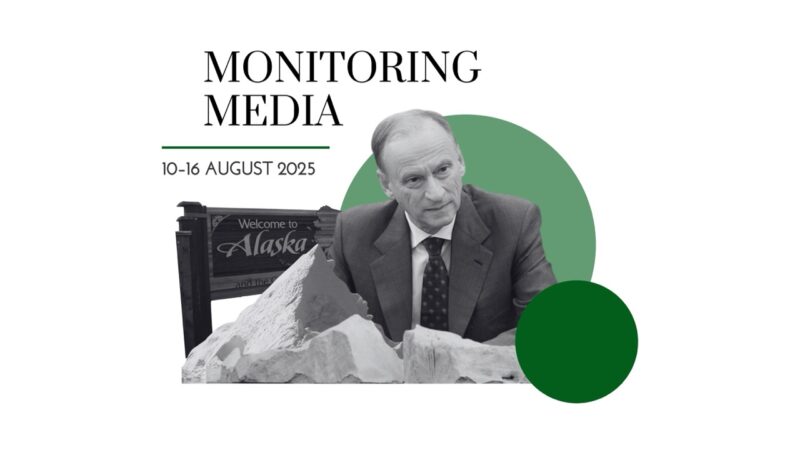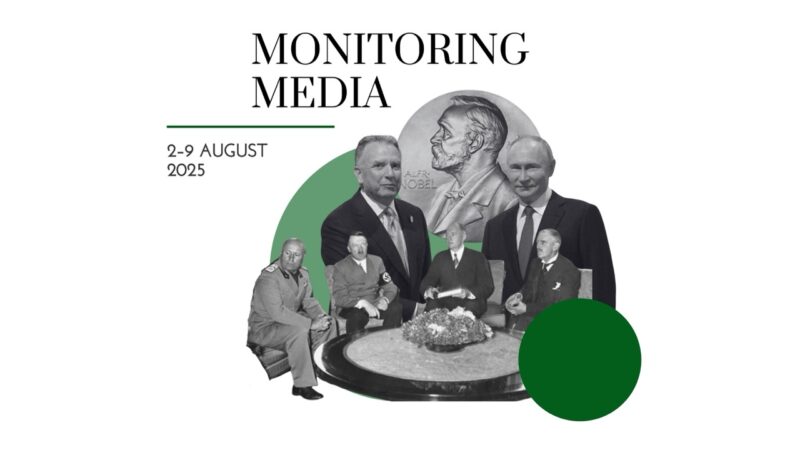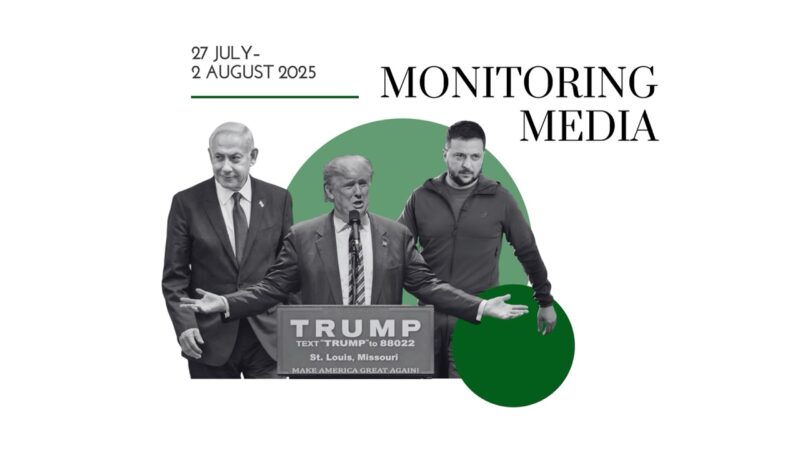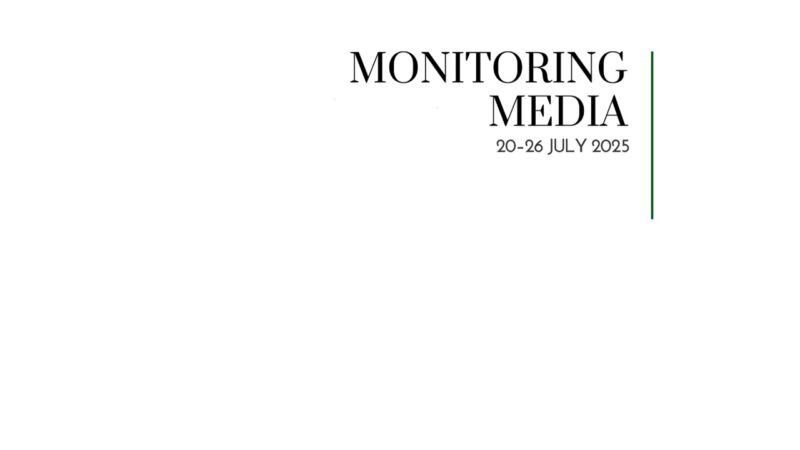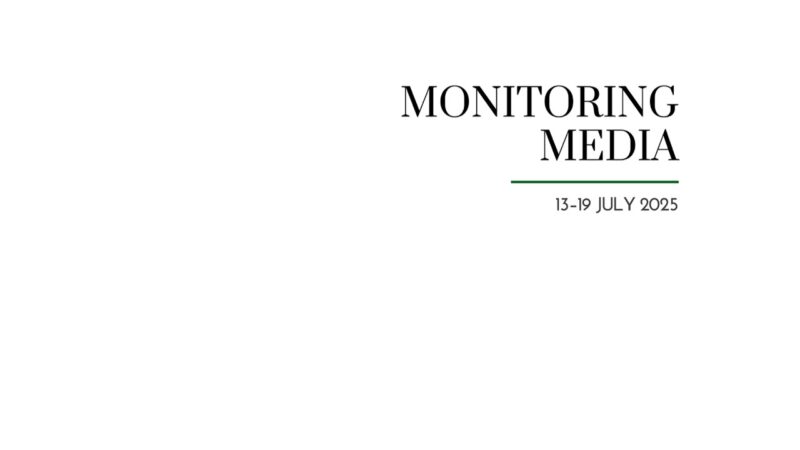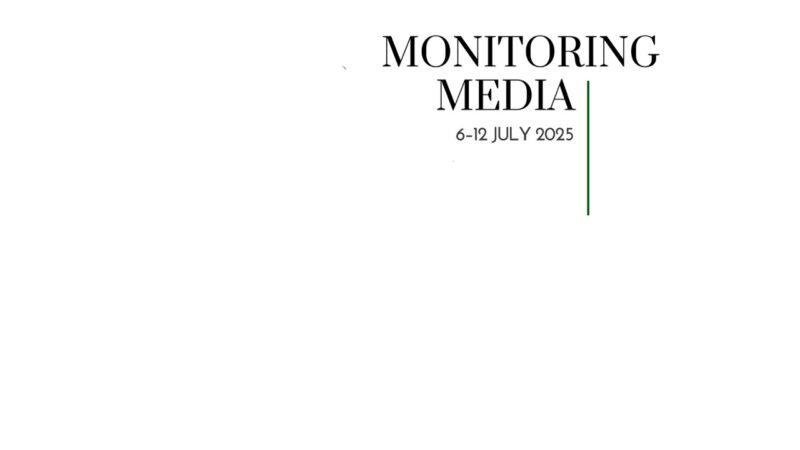Russia issues a new barrage of lies in Europe

CIUS weekly report on North American media coverage of Ukrainian affairs, 12 January –1 February 2025
Five publications (Foreign Policy, Foreign Affairs, The New York Times, Los Angeles Times, and The Globe and Mail) were selected to prepare this report on how Ukraine has been portrayed in the North American press during the past week. The sample was compiled based on their impact on public opinion as well as on their professional reputation, popularity among the readership, and topical relevance. These publications represent centrist viewpoints on the political spectrum.
This MMS report covers only the most-read and relevant articles about Ukraine, as ranked by the respective North American publications themselves in the past week. Its scope covers promoted articles on home pages and articles from special sections on Ukraine, with the hashtag #Ukraine, from the paper editions of the publications, and about Ukraine from opinion columns and editorials.
Featured topics
- The world and Ukraine: Agenda of Russia-US talks goes beyond Ukraine; сorporations are involved in Russia’s war against Ukraine.
- Russia at war: Russia issues a new barrage of lies in Europe; Domino theory about to hit Moscow; Putin uses nostalgia to control Russia’s future, eliminate dissent.
MMS summaries
Agenda goes beyond Ukraine. David E. Sanger and Anton Troianovski (New York Times) argue that the public messages of President Donald Trump and President Vladimir Putin reveal an agenda for resolving the Russo-Ukrainian war. Their public dialogue contains a message about the need to revive the debate on nuclear arms control. According to the authors, “Both men seem to envision taking on the whole relationship between Moscow and Washington, possibly including revived nuclear arms talks, a conversation that has a looming deadline: The major treaty limiting the arsenals of both nations expires in almost exactly a year. After that, they would be free to pursue the kind of arms race the world has not seen since the deepest days of the Cold War.” It is important to understand whether Ukraine will remain on a separate track or become part of the broader negotiations. The second option is more desirable for Moscow and more dangerous for Kyiv. According to the authors, Washington should not assent to Moscow’s proposal to abandon Ukraine to strengthen control over nuclear arsenals.
Russia issues a new barrage of lies in Europe. Luke McGee (Foreign Policy) argues that European countries should step up their fight against Russian disinformation. It is likely that in 2025, Moscow will try to take advantage of the favourable conditions in Europe and intensify its disinformation campaign: “France is stumbling from crisis to crisis after President Emmanuel Macron’s snap election over the summer backfired—all to the benefit of Marine Le Pen, a far-right Putin ally. Germany will hold federal elections in February, where clashes over immigration could see the far-right Alternative for Germany party finish in second place—a big deal in a country that has coalition governments. The far-right, pro-Kremlin Freedom Party has just formed a government in Austria. And in the U.K., immigration will dominate high-profile local elections set to take place in May.” In this way, Moscow seeks to “to spread doubt and discredit the governments in charge of Russia’s adversaries.” The conditions for disinformation to flourish in Europe in the coming years are almost perfect: “The continent’s politics are divided and have no single policy priority. Countries are concerned about everything from inflation to migration, and they are increasingly in search of radical solutions.” According to McGee, “If Putin can use the next few years to disrupt and confuse the West, it could make his monomaniacal vision for the future of eastern Europe easier to achieve.”
Domino theory about to hit Moscow. Casey Michel (Foreign Policy) argues that Russia’s series of failures in the international arena is only gaining momentum. Behind the discussions about the difficult situation in Ukraine, observers haven’t noticed the difficult situation in Russia: “On the economic front, Russia has seen both soaring interest rates and galloping inflation, providing a toxic brew of stagflation, from which there’s little likelihood of escape. On the manpower front, Russian President Vladimir Putin is so skittish of a potential new round of mobilization that he’s forced to rely on North Korean conscripts. And on the tactical front, Putin is no closer to Ukrainian collapse than he was in early 2022. He has created for himself, as scholar Michael Kimmage described, a ‘nightmare,’ with only disastrous choices remaining, both for Putin’s rule and for Russian strategic interests writ large.” According to the author, the Kremlin’s monomaniacal obsession with Ukraine compels it to sacrifice other priorities of Russian foreign policy: “We’ve started to see a Russian variant of a domino theory emerge—one that has begun gutting Russian interests elsewhere, and illustrating, as few other things can, just how atrophied Russian power projection has become.” The first domino fell in 2023 when Azerbaijani troops entered Nagorno-Karabakh. The second domino came down in 2024, when President Bashar al-Assad’s regime in Syria was overthrown. The key question is which dominoes will fall next and how the West can take advantage of this. According to Michel, “Questions and crises of Russia’s internal stability are still a ways off. But that is, ultimately, where this accelerating collapse of dominoes is heading. That is all the more reason the West must begin formulating policy not just on the next dominoes to fall—places like Transnistria, Georgia, and even Belarus—but also on what a post-Putin Russia may well, and should, look like. After all, once they start tumbling, dominoes have a way of continuing to fall. The West should be ready.”
Corporations are involved in the war. Matt Kaplan and Michael Brown (Foreign Affairs) argue that corporations have become an important participant in modern wars. Russia’s war against Ukraine has initiated “a new era of warfare in which commercial companies, many of them American, are likely to provide and secure critical digital infrastructure themselves—crucially, at their own discretion and even for no cost.” For example, thanks to the efforts of AWS and Microsoft to secure Ukrainian government data, Russia’s attack on Ukrainian data centres at the beginning of the full-scale invasion did not cause disruption to key government services. According to the authors, “None of these companies build weaponry; nonetheless, their ability to provide crucial services in the digital realm has become what might be called warfare’s new ‘commercial frontier’: essential battlefield capabilities that are controlled and furnished by civilian technology firms.” Innovation and flexibility will pave the way for such corporations to increasingly be involved in military conflicts. That is why it is important for the US to align their interests with its national interests: “In Ukraine, this alignment was largely due to chance. Ukrainian leaders had developed close personal relationships with some of the corporations that later came to the country’s aid. Moreover, Western countries felt a sense of urgency to defend Ukraine and, crucially, anticipated that the war would be short; the companies offering their services—mostly for free—assumed that the costs of doing so would be low.” According to Kaplan and Brown, “The only way for the US government to ensure that its own interests are advanced at the commercial frontier of warfare is to secure that frontier for itself.”
Trump’s peace deadline for Ukraine faces hard realities of war. ML Cavanaugh (Los Angeles Times) highlights that ending the war in Ukraine is not a simple matter of political will or artificial deadlines, as US President Donald Trump has suggested. While Trump once boasted he could resolve the war within 24 hours of taking office, his peace envoy to Ukraine, Keith Kellogg, has already pushed that deadline back by at least 100 days. Cavanaugh underscores that peace cannot be dictated on a timeline but must be built on the “hard ground truths” of war. As Gen. Dwight D. Eisenhower once said, “Sometimes it just gets down to the dirty job of killing until one side or the other cracks.” At present, the author believes that the Russian forces are closer to breaking than the Ukrainian troops, despite their ability to absorb more losses. Ukraine, fighting for its survival, has retaken more than half of the land Russia once occupied, and its forces have maintained high morale despite the staggering costs. With more than 400,000 Ukrainian and 700,000 Russian casualties reported (actual numbers might be much higher), the war is sustainable for both sides, making an immediate peace deal unlikely. Cavanaugh notes that Russia has turned to unconventional means—recruiting North Korean troops and relying on convicts—to bolster its war effort, while Ukraine remains motivated by its struggle for sovereignty. Any US-brokered peace deal must balance two conflicting foreign policy objectives: supporting Ukrainian independence while preventing Russia from further alignment with China. According to Cavanaugh, an ideal solution would avoid emboldening Russia to strike again while also ensuring Ukraine’s security, possibly through a NATO-style military presence in the country. However, Kyiv has little incentive to negotiate, given its determination to fight “until the last Ukrainian” and the belief that time is on its side. Finally, the author argues that war is won through endurance rather than quick diplomatic fixes. Given that neither Ukraine nor Russia appears ready to concede, the author dismisses Trump’s simplistic approach, comparing it to “hoping to bring peace by howling at the moon.” The reality is that wars do not end on a schedule, and any attempt to impose an artificial deadline is unrealistic.
Trump’s “Ukraine gamble” counts on economic pressure, diplomacy to end the war. Amy MacKinnon (Foreign Policy) argues that despite his campaign pledge to end the war in Ukraine immediately, US President Donald Trump has found negotiations to be far more complex than anticipated. During his first week in office, Trump, alongside the presidents of Ukraine and Russia, set the stage for a US-led diplomatic effort, but fundamental disagreements persist. While Ukrainian President Volodymyr Zelensky warned European leaders that a robust military presence is needed to deter future Russian aggression, Trump threatened “high levels” of economic pressure on Russia to push for a settlement. Russian President Vladimir Putin, meanwhile, signalled a willingness to negotiate but maintained his ultimate goal of subjugating Ukraine. Former US Ambassador to Russia Michael McFaul said: “I’ve seen no public evidence, or heard from anyone that I trust who knows Putin well, that indicates he is ready to negotiate.” Analysts widely agree that Moscow’s war objectives remain unchanged, as Putin continues to insist on stripping Ukraine of its sovereignty and NATO ambitions. MacKinnon insists that economic pressure alone is unlikely to force Russia to the negotiating table. Despite heavy sanctions, inflation, and military losses exceeding over half a million troops, Putin’s economy has adapted—through alliances with Iran, China, and North Korea—while surging defence spending has propped up the domestic economy. Thus, with military and economic coercion proving insufficient, Trump’s team has floated compromise solutions, including a “temporary loss” of Ukrainian territories in exchange for US security guarantees and delaying NATO membership. However, it is by no means certain that Putin would respect such a deal. As Michael Carpenter warned: “I think one has to assume that Russia will use any temporary cease-fire or even a peace agreement to rearm and refit and eventually attack at a time of their choosing.”
Putin uses nostalgia to control Russia’s future, eliminate dissent. Nina L. Khrushcheva (Globe and Mail) notes that nostalgia in Russia serves as both a coping mechanism and a tool for political control, allowing the government to maintain power while stifling dissent. Many Russians, especially older generations, romanticize the Soviet era, recalling it as a time of stability and strength. This nostalgia is not just about personal memories but is actively cultivated by the state. As Krushcheva explains, “promoting an idealized version of the past legitimizes a repressive present and future.” By celebrating Soviet symbols and figures such as Lenin, Stalin, and cosmonauts, the Kremlin reassures the public that the past was better than the present. This allows the government to suppress any desire for change, as Russians focus on a glorified version of history. Putin has been strategic in fostering this nostalgia, seeing it as a way to both comfort and control the population. Since coming to power, Putin has embraced former totalitarian symbols like the Soviet national anthem and Red Army flag, using them to strengthen national pride and discourage critical thinking. The author notes that Putin’s actions, such as reviving Soviet-era films and songs, are aimed at reinforcing a sense of national unity while deflecting attention from current challenges. “If Russians are gripped by a yearning for an imaginary past, they will not fight for a better future, and the Kremlin effectively has free rein to restore and entrench elements of the actual past that are anything but desirable,” Khrushcheva concludes. “Nothing can break a person out of their nostalgic reverie like gulags and forced disappearances.”
Putin’s speech 20 years ago set the stage for Russia’s authoritarian shift. Garry Kasparov (Globe and Mail) identifies Vladimir Putin’s 2005 speech to the Russian Federal Assembly as a pivotal moment that set the course for his dictatorship and shaped Russia’s trajectory in the following decades. This speech is viewed as a direct manifestation of Putin’s geopolitical vision, marking the beginning of a broader agenda to restore Russia’s influence and global power. The speech’s central message was a clear rejection of the post-Soviet world order. “The collapse of the Soviet Union was the greatest geopolitical catastrophe of the 20th century,” Putin said then, signalling his intent to reverse the effects of the Soviet Union’s dissolution and challenge the West. The author argues that this moment lay the groundwork for Russia’s future aggression, which would escalate as Putin gained more power. Examining Putin’s psychological tactics, Kasparov—a Russian pro-democracy leader, author, and former world chess champion—explains how dictators often lie about their past actions to present a distorted image of their success, while simultaneously being very direct about their future plans. This approach is exemplified in Putin’s 2005 speech, which outlined his vision for Russia’s resurgence. The speech marked a shift from symbolic gestures, like the restoration of the Soviet anthem, to more aggressive actions. As Kasparov points out, Putin saw a lack of significant opposition from the West to Russia’s provocative past actions, including the brutal Second Chechen War and the annexation of Crimea. Kasparov concludes by framing the current war as a continuation of the broader ideological battle between the West and authoritarian regimes, with Putin at the center of this conflict. The conflict with Russia is now “ideological and cannot end but with a complete realization of the vision of the winning side.” The West needs to recognize the reality of the ongoing war and resist Putin’s vision with bold actions, not just words, as only decisive measures will secure a future free from authoritarian control.
